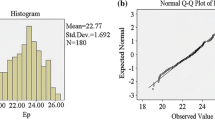Abstract
As an important material for manufacturing resonant components of musical instruments, Paulownia has an important influence on the sound quality of Ruan. In this paper, a model for evaluating the sound quality of Ruan based on the vibration characteristics of wood is developed using machine learning methods. Generally, the selection of materials for Ruan manufacturing relies primarily on manually weighing, observing, striking, and listening by the instrument technician. Deficiencies in scientific theory have hindered the quality of the finished Ruan. In this study, nine Ruans were manufactured, and a prediction model of Ruan sound quality was proposed based on the raw material information of Ruans. Out of a total of 180 data sets, 145 and 45 sets were chosen for training and validation, respectively. In this paper, typical correlation analysis was used to determine the correlation between two single indicators in two adjacent pairwise combinations of the measured objects in each stage of the production process in Ruan. The vibration characteristics of the wood were tested, and a model for predicting the evaluation of Ruan’s acoustic qualities was developed by measuring the vibration characteristics of the resonating plate material. The acoustic quality of the Ruan sound board wood was evaluated and predicted using machine learning model generalized regression neural network. The results show that the prediction of Ruan sound quality can be achieved using Matlab simulation based on the vibration characteristics of the soundboard wood. When the model-predicted values were compared with the traditional predicted results, it was found that the generalized regression neural network had good performance, achieving an accuracy of 93.8% which was highly consistent with the experimental results. It was concluded that the model can accurately predict the acoustic quality of the Ruan based on the vibration performance of the soundboards.


Similar content being viewed by others
References
Buksnowitz C, Teischinger A, Muller U, Pahler A, Evans R (2007) Resonance wood (Picea abies (L.) Karst.)—evaluation and prediction of violin makers’ quality-grading. J Acoust Soc Am 121:2384–2395. https://doi.org/10.1121/1.2434756
Cho CL (2007) Comparison of three methods for determining Young’s modulus of wood. Taiwan Lin Ye Ke Xue 22(3):297–306. https://doi.org/10.7075/TJFS.200709.0297
Damodaran A, Lessard L, Babu AS (2015) An overview of fibre-reinforced composites for musical instrument soundboards. Acoust Aust 43:117–122. https://doi.org/10.1007/s40857-015-0008-5
Duerinck T, Verberkmoes G, Fritz C, Leman M, Nijs L, Kersemans M, Van Paepegem W (2020) Listener evaluations of violins made from composites. J Acoust Soc Am 147:2647–2655. https://doi.org/10.1121/10.0001159
Islam MZ, Sarker ME, Rahman MM, Islam MR, Ahmed ATMF, Mahmud MS, Syduzzaman M (2022) Green composites from natural fibers and biopolymers: A review on processing, properties, and applications. J Reinf Plast Compos 41(13–14):526–557. https://doi.org/10.1177/07316844211058708
Jiang YQ, Sun XH, Liang XJ, Li ZJ, Li W (2020) Analysis of Chinese musical instrument timbre based on objective features. Fu Dan Xue Bao Zi Ran Ke Xue Ban 59:346. https://doi.org/10.15943/j.cnki.fdxb-jns.2020.03.014 (in Chinese)
Karami E, Bardet S, Matsuo M, Bremaud I, Gaff M, Gril J (2020) Effects of mild hygrothermal treatment on the physical and vibrational properties of spruce wood. Compos Struct 253:112736. https://doi.org/10.1016/j.compstruct.2020.112736
Kubojima Y, Okano T, Ohta M (1998) Vibrational properties of Sitka spruce heat-treated in nitrogen gas. J Wood Sci 44:73–77. https://doi.org/10.1007/BF00521878
Kubojima Y, Yoshihara H, Ohsaki H, Ohta M (2000) Accuracy of shear properties of wood obtained by simplified Iosipescu shear test. J Wood Sci 46:279–283. https://doi.org/10.1007/BF00766217
Leite ERS, Hein PRG, Souza TM, Rabelo GF (2012) Estimation of the dynamic elastic properties of wood from Copaifera langsdorffii Desf using resonance analysis. Cerne 18:41–47. https://doi.org/10.1590/S0104-77602012000100006
Liu FXZ, Wang KQ, Lang CH, Guan FW, Jiang JH, Qiu YP (2021) Mechanical and acoustic emission properties of vegetable fiber-reinforced epoxy composites for percussion instrument drums. Polym Compos 42:2864–2871. https://doi.org/10.1002/pc.26020
Lu JX, Jiang JL, Wu YQ, Li XJ, Cai ZY (2012) Effect of moisture sorption state on vibrational properties of wood. For Prod J 62(3):171–176. https://doi.org/10.13073/0015-7473-62.3.171
Matsunaga M, Sugiyama M, Minato K, Norimoto M (1996) Physical and mechanical properties required for violin bow materials. Holzforschung 50(6):511–517. https://doi.org/10.1515/hfsg.1996.50.6.511
Murata K, Kanazawa T (2007) Determination of Young’s modulus and shear modulus by means of deflection curves for wood beams obtained in static bending tests. Holzforschung 61(5):589–594. https://doi.org/10.1515/HF.2007.082
Noguchi T, Obataya E, Ando K (2012) Effects of aging on the vibrational properties of wood. J Cult Herit 13(3):S21–S25. https://doi.org/10.1016/j.culher.2012.02.008
Ono T, Norimoto M (1983) Study on Young’s modulus and internal friction of wood in relation to the evaluation of wood for musical instruments. Jpn J Appl Phys 22(4R):611. https://doi.org/10.1143/JJAP.22.611
Ono T, Norimoto M (1985) Anisotropy of dynamic Young’s modulus and internal friction in wood. Jpn J Appl Phys 24(8R):960. https://doi.org/10.1143/JJAP.24.960
Shirmohammadi M, Faircloth A, Redman A (2020) Determining acoustic and mechanical properties of Australian native hardwood species for guitar fretboard production. Holz Roh Werkst 78:1161–1171. https://doi.org/10.1007/s00107-020-01599-6
Traore B, Brancheriau L, Perre P, Stevanovic T, Diouf P (2010) Acoustic quality of vene wood (Pterocarpus erinaceus Poir.) for xylophone instrument manufacture in Mali. Ann for Sci. https://doi.org/10.1051/forest/2010054
Yang Y, Liu YX, Liu ZB, Shi SQ (2017) Prediction of Yueqin acoustic quality based on soundboard vibration performance using support vector machine. J Wood Sci 63:37–44. https://doi.org/10.1007/s10086-016-1598-8
Zhu XC (2020) Research on short-term power load forecasting method based on IFOA-GRNN. Power Syst Prot Control 48:121–127. https://doi.org/10.19783/j.cnki.pspc.190760 (in Chinese)
Author information
Authors and Affiliations
Corresponding author
Additional information
Publisher's Note
Springer Nature remains neutral with regard to jurisdictional claims in published maps and institutional affiliations.
Project funding: The work was supported by China Postdoctoral Science Foundation (2019M651240), and National Natural Science Foundation of China (31670559).
The online version is available at http://www.springerlink.com
Corresponding editor: Yu Lei.
Rights and permissions
Springer Nature or its licensor (e.g. a society or other partner) holds exclusive rights to this article under a publishing agreement with the author(s) or other rightsholder(s); author self-archiving of the accepted manuscript version of this article is solely governed by the terms of such publishing agreement and applicable law.
About this article
Cite this article
Yang, Y. Vibration properties of Paulownia wood for Ruan sound quality using machine learning methods. J. For. Res. 35, 9 (2024). https://doi.org/10.1007/s11676-023-01655-w
Received:
Accepted:
Published:
DOI: https://doi.org/10.1007/s11676-023-01655-w




